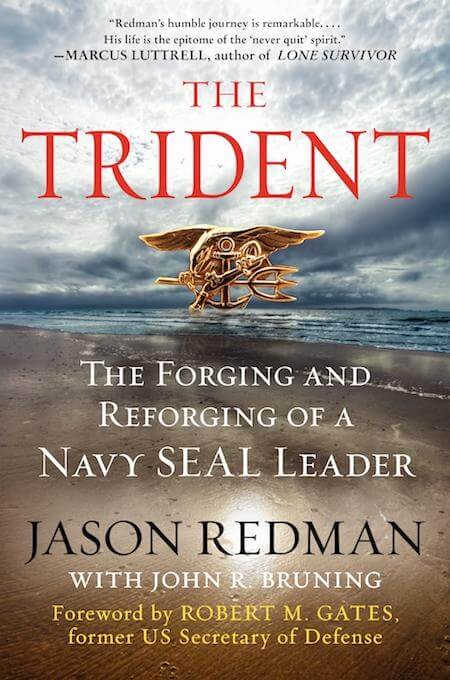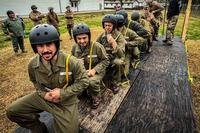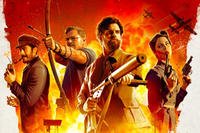
Some of our readers know former Navy SEAL Jason Redman because they've seen photos of a sign he posted outside his door at the National Naval Medical Center in Bethesda after he was wounded in a 2007 raid against an al-Qaida leader in Iraq.
Redman's determination resonated with a lot of people and now he's written a memoir called The Trident: The Forging and Reforging of a Navy SEAL Leader that puts the sign in context and tells both a more complicated and more interesting story than the one suggested by his "Like and Share" Facebook moment.
The book details his early SEAL career in the '90s, his decision to enroll in college just before 9/11and his return to service in Afghanistan and Iraq. Jay answered our questions via email.

When and how did you decide to join the Navy? Is there a tradition of service in your family? When did you want to become a SEAL?
My family does indeed come from a tradition of military service. My grandfather was a decorated WWII B-24 pilot flying over Europe. My great Uncle was shot down in the Pacific during the early years of WWII. My father was a US Army Airborne Rigger and Jumpmaster during the Vietnam War. My sister is an Air Force Officer and my brother was a Marine. I learned about the SEAL Teams from my Dad when I was about fourteen years old. He told me they were good in the water, they blew things up, they jumped out of planes, and they were crazy. He said I’d fit right in and I never looked back from that goal since that day.
What led you to enroll at Old Dominion University in 2001? Did you always plan to return to service after college?
When I decided to go to college and get a commission it was before 9/11 so it seemed like a logical step to follow in the footsteps of my father and grandfather. Fortunately, the Navy had a program for enlisted service members to get a commission called the Seaman to Admiral program. The program is set up to take Active duty Navy enlisted members and send them through school and then bring them back to the Navy as officers without ever having a break in service. I was selected in 2000, started school in 2001 and was commissioned as a Naval Special Warfare officer in 2004.
You talk a lot about the Navy SEAL myth in the book. Can you talk how that myth compared with the reality of your own service?
There is a mystique and aura about Special Operations that at times is intentional and at times is formulated from the public’s own romantic beliefs. The SEAL Teams are no different in this. The myth of the brotherhood of warriors is very real. Technology and tactics have developed but the bond of men who go to war has not and that culture is very much alive. The myth was not as romantic as I believed as a young man, because in reality, there is nothing romantic about witnessing the destruction of war, especially when it is one of your own brothers who is being buried as a by product. Unfortunately, there will always be evil men, who will need good brave men to stand against them. In this manner, the myth is alive and well.
You were wounded in Iraq in 2007 during a mission against an al-Qaida leader. You ended at Bethesda for treatment and a photo of a sign you put outside your door became an online sensation. Talk about your experience in Iraq, what your thinking was when you made the sign and when you realized how much of an impact your words were having on others.
I was at a very unique point in my career when I headed to Iraq. I grew up somewhat arrogant and immature in a peacetime military. I earned my commission and headed to war in Afghanistan where many of my personal beliefs and imperfections almost ended my career. After humbling myself and slowly earning back the trust of the men I as entrusted to lead, I headed to Iraq at a very volatile point in the War. It was everything you ever hope for in a successful combat deployment. We were actively targeting bad people and tangibly making a difference in Al Anbar. It was a tremendous learning experience for me personally, as a leader, and warrior.

The Sign came about because a few people came into my room with sorrow for the wounds I received and I pledged shortly after I was wounded to not feel sorry for myself, so I wasn’t going to allow anyone else to feel sorry for me. This was the catalyst for the Sign. A few days later, a fellow Teammate stuck his Trident in the bottom on the door. A lot of people want to make a big deal about how I wrote the sign, but I tell everyone the same thing. 90% of all wounded warriors have that same mentality. I just happened to capture it in writing. This is why the Sign now hangs on the wounded ward at Walter Reed. It is for the warriors.
What led you to decide to write “The Trident”? What do you hope readers take away from the book?
I never intended to write a book. I have always written, from personal stories to poetry, and began writing as I recovered. Having come that close to death and spending years in the hospital getting put back together, gave me a lot of time to reflect on my life, the second chance I was given, and the lessons I had learned throughout my career. After I wrote about twenty chapters, I shared them with some friends, who convinced me I needed to do something with it. I was still active duty so I took what I had done to my leadership and they agreed it was a good representation of Naval Special Warfare and gave me the go ahead to move forward with it. Two years later with the help of John R. Bruning, we had a completed book, and the approval of Naval Special Warfare and the Department of Defense.
I hope readers walk away from this book motivated and inspired; motivated to be better people, leaders, family members or even warriors if they come from that community. Inspired to overcome any adversity, mistakes, or obstacles that all of us encounter in life.
You founded a company called Wounded Wear. Tell our readers about the business.
Wounded Wear is a non-profit organization I founded after I was wounded to help fellow warriors and families of the fallen “Rediscover the Hero Within” through clothing, clothing modifications, empowering events and connecting them to opportunities. Ultimately, we are striving to make a difference in the lives of our warriors and families of the fallen by showing them their sacrifice was worth it; that the American people recognize that. We want to show them that their life did not end, even if their military career did, or if they lost a loved one. We exist to empower them to overcome and embrace life fully through skydiving or any event that makes them once again live life greatly. We also try to connect them to other organizations doing great things, from educational opportunities to employment opportunities.




